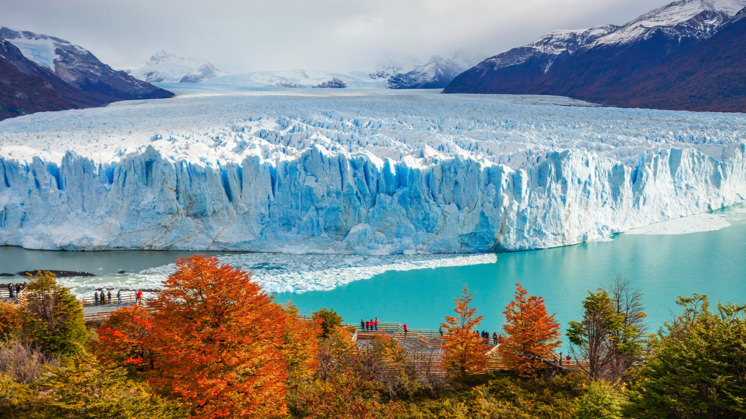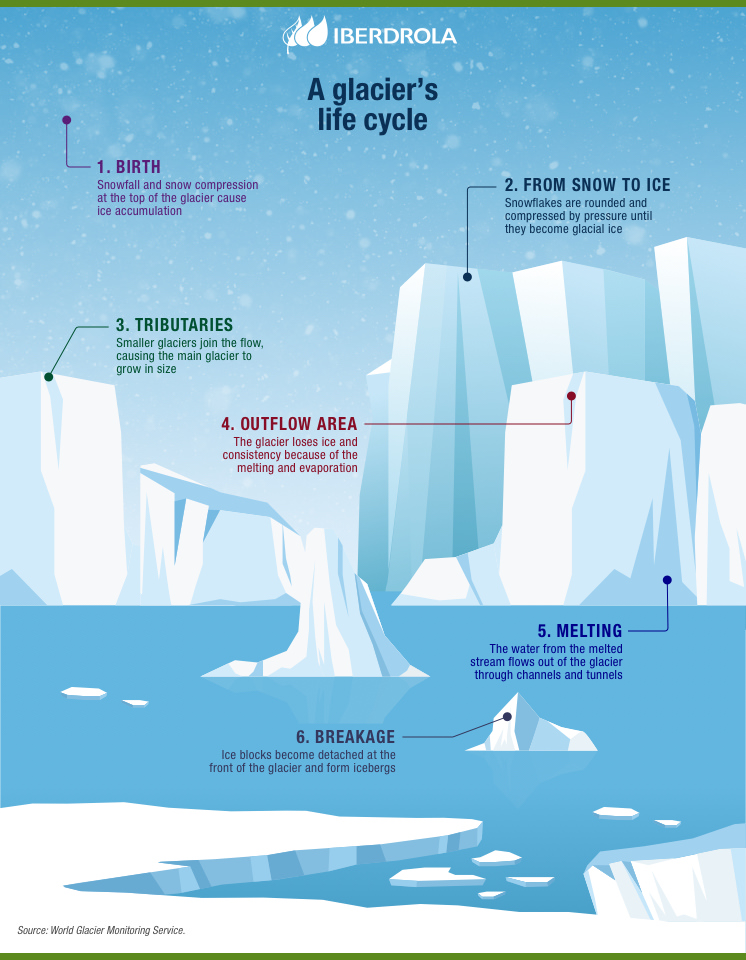Melting glaciers
Glaciers, the great guardians of the stability of the planet's climate
The melting of the glaciers, a phenomenon that intensified in the 20th century, is leaving our planet iceless. Human activity is the main culprit in the emission of carbon dioxide and other greenhouse gases. The sea level and global stability depend on how these great masses of recrystallized snow evolve.

The Earth's glaciers have been silently retreating for more than half a century as climate change inexorably marches on. There is no place on the planet — except south-east Asia — capable of withstanding the effects of a phenomenon that has melted more than 9.6 billion tonnes of glacial ice in the world since 1961, according to a 2019 satellite study by the University of Zurich (Switzerland), and threatens to evaporate over a third of all glaciers by 2100, according to the World Wildlife Fund.
What is a glacier and how does it form?
These massive blocks of moving ice arise as snow accumulated in cold places compacts and recrystallizes, as is the case, for example, in mountain and polar glaciers, which should not be confused with the gigantic Arctic plates. Glaciers are classified according to their morphology — ice fields, cirque glaciers, valley glaciers, etc. — the climate — polar, tropical or temperate — and their thermal conditions — cold, hot or polythermal base —.
The formation of a glacier takes millennia, and its size varies depending on the amount of ice it retains throughout its lifespan. The behaviour of these masses is reminiscent of that of the rivers they feed during thaws, and their speed depends on friction and the slope of the terrain over which they move. In total, glaciers cover 10% of the Earth's surface and, along with the ice caps, account for nearly 70% of the world's fresh water.
Why do glaciers melt? Causes
The rising temperature of the Earth has, without doubt, been responsible for melting glaciers throughout history. Today, the speed with which climate change is progressing might render them extinct in record time. Let us take a detailed look at the causes behind glacial melting:
- CO2 emissions: the atmospheric concentration of carbon dioxide and other greenhouse gases (GHGs) produced by industry, transport, deforestation and burning fossil fuels, amongst other human activities, warm the planet and cause glaciers to melt.
- Ocean warming: oceans absorb 90% of the Earth's warmth, and this fact affects the melting of marine glaciers, which are mostly located near the poles and on the coasts of Alaska (United States).

SEE INFOGRAPHIC: A glacier's life cycle [PDF]
Effects of melting glaciers
In the aforementioned study, the University of Zurich revealed that glacial melting has accelerated over the last three decades. This loss of ice has already reached 335 billion tonnes per year, which is 30% of the current rate of ocean growth. The main consequences of deglaciation are:
 Sea level rise
Sea level rise
Glacial melting has contributed to raising sea levels by 2.7 centimeters since 1961. Furthermore, the world's glaciers contain enough ice — about 170,000 cubic kilometres — to raise sea levels by nearly half a metre.
 Impact on the climate
Impact on the climate
Glacial thawing at the poles is slowing the oceanic currents, a phenomenon related to altering the global climate and a succession of increasingly extreme weather events throughout the globe.
 Disappearance of species
Disappearance of species
Glacial melting will also cause the extinction of numerous species, as glaciers are the natural habitat of a number of animals, both terrestrial and aquatic.
 Less fresh water
Less fresh water
The disappearance of glaciers also means less water for consumption by the population, a lower hydroelectric energy generation capacity, and less water available for irrigation.
Solutions to avoid melting glaciers
Glaciologists believe that, despite the massive ice loss, we do still have time to save the glaciers from their predicted disappearance. Here are some ideas and proposals for how we can help achieve this goal:
 Stop climate change
Stop climate change
In order to curtail climate change and save the glaciers, it is indispensable that global CO2 emissions be reduced by 45 % over the next decade, and that they fall to zero after 2050.
 Slow down their erosion
Slow down their erosion
The scientific journal Nature suggested building a 100-metre-long dam in front of the Jakobshavn glacier (Greenland), the worst affected by Arctic melting, to contain its erosion.
 Combine artificial icebergs
Combine artificial icebergs
Indonesian architect Faris Rajak Kotahatuhaha won an award for his project Refreeze the Arctic, which consists of collecting water from melted glaciers, desalinating it and refreezing it to create large hexagonal ice blocks. Thanks to their shape, these icebergs could then be combined to create frozen masses.
 Increase their thickness
Increase their thickness
The University of Arizona proposed a seemingly simple solution: manufacture more ice. Their proposal consists of collecting ice from below the glacier through pumps driven by wind power to spread it over the upper ice caps, so that it will freeze, thus strengthening the consistency.




